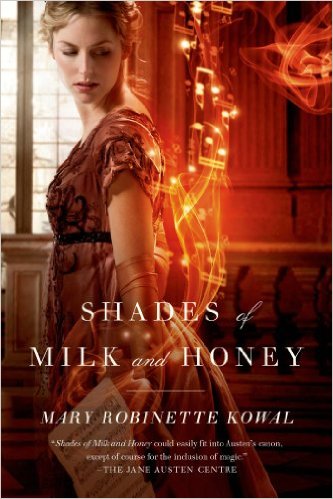Shades of Milk and Honey, by Mary Robinette Kowal
May 16
2016

The back cover of Mary Robinette Kowal's novel Shades of Milk and Honey describes it as “precisely the sort of tale we would expect from Jane Austen”. That comment is... a little hyperbolic, to put it mildly, but Kowal's book has its own virtue.
Shades of Milk and Honey is set in an alternate-universe version of Regency England; a world in which magic plays a role in everyday life. Kowal's heroine is Jane Ellsworth, a well-bred young woman of 28, whose remarkable talent for the manipulation of glamour doesn't quite make up for her plain face and lack of dowry. When her younger sister Melody threatens to cause a scandal, Jane discovers that her own magical gift—along with her intelligence and common sense—might save her family's reputation, and lead to something other than a quiet future as a respectable spinster.
My least favorite aspect of this novel is the fact that literally every female character other than the heroine is naive, silly, or cruel (or some combination of the three). I run into this set-up a lot, and I assume it's meant to make the heroine seem even more wonderful by comparison. It doesn't work: the ability to appreciate and befriend others is important, and Jane would have been a more sympathetic character if she was depicted as having real, peer-based friendships. When the author limits Jane's “friends” to a prickly bond with Melody and a mentor-type relationship with a neighbor who is twelve years her junior, I automatically assume her social isolation is at least partially her own fault.
Happily, Shades of Milk and Honey is redeemed by Kowal's inventive depiction of magic, which is portrayed as another domestic art, like painting or music. As with most other “accomplishments”, upper-class women are expected to be competent at glamour, but their talents are limited by their sex—they should be good enough to show off at a party or decorate a drawing room, but actual fame is limited to men. I found the gender and class aspects of this absolutely fascinating, and wished that the book had explored them in even greater detail: do servants use glamour? What are the class implications of magical talent? Are there other forms of magic? Kowal has written four more books in this series, and while I might object to her characterization choices, I'm sufficiently invested in her wonderfully creative world-building to read every last one of them.
Shades of Milk and Honey is set in an alternate-universe version of Regency England; a world in which magic plays a role in everyday life. Kowal's heroine is Jane Ellsworth, a well-bred young woman of 28, whose remarkable talent for the manipulation of glamour doesn't quite make up for her plain face and lack of dowry. When her younger sister Melody threatens to cause a scandal, Jane discovers that her own magical gift—along with her intelligence and common sense—might save her family's reputation, and lead to something other than a quiet future as a respectable spinster.
My least favorite aspect of this novel is the fact that literally every female character other than the heroine is naive, silly, or cruel (or some combination of the three). I run into this set-up a lot, and I assume it's meant to make the heroine seem even more wonderful by comparison. It doesn't work: the ability to appreciate and befriend others is important, and Jane would have been a more sympathetic character if she was depicted as having real, peer-based friendships. When the author limits Jane's “friends” to a prickly bond with Melody and a mentor-type relationship with a neighbor who is twelve years her junior, I automatically assume her social isolation is at least partially her own fault.
Happily, Shades of Milk and Honey is redeemed by Kowal's inventive depiction of magic, which is portrayed as another domestic art, like painting or music. As with most other “accomplishments”, upper-class women are expected to be competent at glamour, but their talents are limited by their sex—they should be good enough to show off at a party or decorate a drawing room, but actual fame is limited to men. I found the gender and class aspects of this absolutely fascinating, and wished that the book had explored them in even greater detail: do servants use glamour? What are the class implications of magical talent? Are there other forms of magic? Kowal has written four more books in this series, and while I might object to her characterization choices, I'm sufficiently invested in her wonderfully creative world-building to read every last one of them.
Posted by: Julianka
No new comments are allowed on this post.
Comments
No comments yet. Be the first!